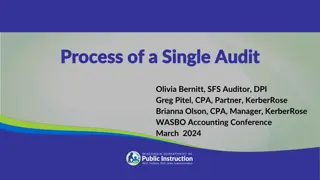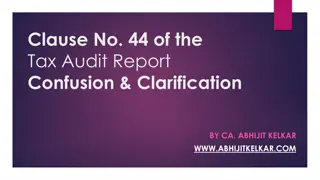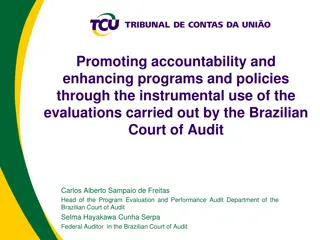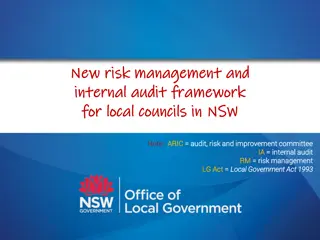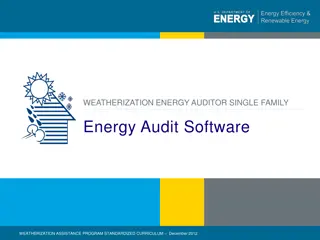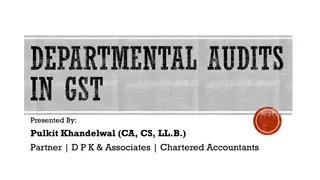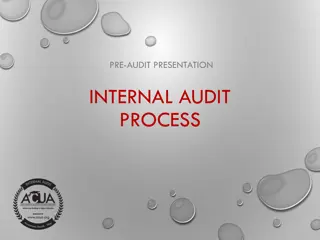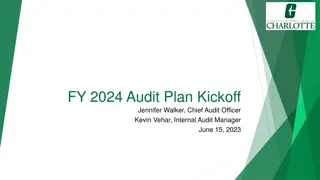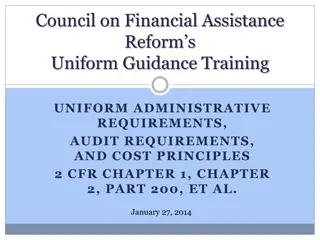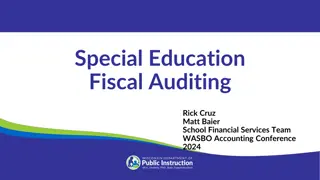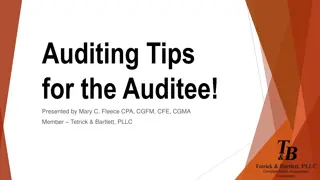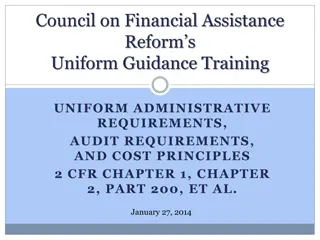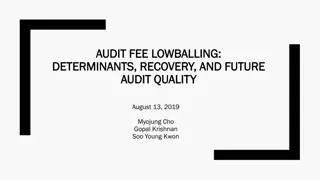Preparing for a Single Audit Under the Uniform Guidance: Insights for Auditees
Gain valuable insights on preparing for a single audit under the Uniform Guidance from a governmental audit quality center web event. Explore troubleshooting tips, educational requirements, and more to enhance audit quality.
Download Presentation

Please find below an Image/Link to download the presentation.
The content on the website is provided AS IS for your information and personal use only. It may not be sold, licensed, or shared on other websites without obtaining consent from the author.If you encounter any issues during the download, it is possible that the publisher has removed the file from their server.
You are allowed to download the files provided on this website for personal or commercial use, subject to the condition that they are used lawfully. All files are the property of their respective owners.
The content on the website is provided AS IS for your information and personal use only. It may not be sold, licensed, or shared on other websites without obtaining consent from the author.
E N D
Presentation Transcript
Preparing for a Single Audit Under the Uniform Guidance: An Auditee Perspective A Governmental Audit Quality Center Web Event
Administrative Notes Please ensure your pop-up blocker is disabled. Note the interactive toolbar at the bottom of your screen. Download slides and materials by clicking this icon. Ask questions by entering your question in the Q&A box. Please click the Help and/or Contact Us at the bottom of your screen. Call AICPA Member Service at 888.777.7077. 2 Governmental Audit Quality Center
Trouble Shooting Troubleshooting Tips No Audio? Ensure that your computer speakers are turned on and that the volume is appropriately set Check to ensure that audio streaming is enabled on your computer If the presentation slides stop advancing during the presentation Close out of the presentation and re-launch the webcast If you are still having audio or other technical difficulty Check with your IT personnel at your firm or state audit organization (SAO) to ensure that this event is not being blocked by a firewall Call the AICPA Service Center at 888.777.7077 3 Governmental Audit Quality Center
Continuing Professional Education You must answer at least 75% of the random attendance checks to earn CPE credit. Please respond to the attendance checks during the live presentation. You are not eligible to earn CPE by watching the archive of this event. At the end of today s presentation we will provide steps for obtaining your CPE certificate 4 Governmental Audit Quality Center
Presenters Eric Formberg, CPA PlanteMoran and Shelly Hammond, CPA Allen, Gibbs & Houlik, L.C. 5 Governmental Audit Quality Center
Todays Event Hosted by the GAQC The Governmental Audit Quality Center (GAQC) was established in 2004 Over 1,900 members (firms and State Auditor Organizations) Members make a commitment to audit quality Adhere to membership requirements GAQC assists auditors by providing information, tools, resources, training, and more! - Some GAQC resources for general public, including auditees 6 Governmental Audit Quality Center
What We Will Cover Today Background and Overview of Uniform Administrative Requirements, Cost Principles, and Audit Requirements for Federal Awards at 2 CFR 200 (UG or Uniform Guidance) Overview of Auditor Responsibilities Auditee Responsibilities Compliance Requirements Internal Control Reporting Tips for Auditees Resources 7 Governmental Audit Quality Center
Background and Overview of Uniform Guidance 8 Governmental Audit Quality Center
Key Issuances Uniform Guidance December 2013 Final Uniform Guidance December 2014 Joint Interim Final Rule Accomplished agency adoption of Uniform Guidance Not totally uniform Technical corrections (some UG shoulds changed to must) July 2015 - Federal Register notice September 2015 3rd update to Council on Financial Reform (COFAR) Frequently Asked Questions (FAQs) September 2015 - Federal Register notice 2 year extension of procurement (one additional year beyond that granted in original FAQs) Technical corrections 9 Governmental Audit Quality Center
Agency Adoption 2 CFR Part 200 Locations 2 CFR Part Range 300-399 400-499 600-699 700-799 800-899 900-999 1000-1099 1100-1199 1200-1299 1300-1399 1400-1499 1500-1599 1800-1899 2000-2099 2200-2299 2300-2399 2400-2499 2500-2599 2600-2699 2700-2799 2800-2899 2900-2999 3000-3099 3100-3199 3200-3299 3300-3399 3400-3499 3500-3599 3600-3699 3700-3799 5800-5899 5900-5999) Agency Name DEPARTMENT OF HEALTH AND HUMAN SERVICES DEPARTMENT OF AGRICULTURE DEPARTMENT OF STATE AGENCY FOR INTERNATIONAL DEVELOPMENT DEPARTMENT OF VETERANS AFFAIRS DEPARTMENT OF ENERGY DEPARTMENT OF TREASURY DEPARTMENT OF DEFENSE DEPARTMENT OF TRANSPORTATION DEPARTMENT OF COMMERCE DEPARTMENT OF THE INTERIOR ENVIRONMENTAL PROTECTION AGENCY NATIONAL AERONAUTICS AND SPACE ADMINISTRATION UNITED STATES NUCLEAR REGULATORY COMMISSION CORPORATION FOR NATIONAL AND COMMUNITY SERVICE SOCIAL SECURITY ADMINISTRATION DEPARTMENT OF HOUSING AND URBAN DEVELOPMENT NATIONAL SCIENCE FOUNDATION NATIONAL ARCHIVES AND RECORDS ADMINISTRATION SMALL BUSINESS ADMINISTRATION DEPARTMENT OF JUSTICE DEPARTMENT OF LABOR DEPARTMENT OF HOMELAND SECURITY INSTITUTE OF MUSEUM AND LIBRARY SERVICES NATIONAL ENDOWMENT FOR THE ARTS NATIONAL ENDOWMENT FOR THE HUMANITIES DEPARTMENT OF EDUCATION EXPORT-IMPORT BANK OF THE UNITED STATES OFFICE OF NATIONAL DRUG CONTROL POLICY, EXECUTIVE OFFICE OF THE PRESIDENT PEACE CORPS ELECTION ASSISTANCE COMMISSION GULF COAST ECOSYSTEM RESTORATION COUNCIL 10 Governmental Audit Quality Center
Non- federal entities Federal Agencies Implement the new administrative requirements and cost principles for all new Federal awards made on or after December 26, 2014, and to incremental funding made after that date Implement policies and procedures by promulgating regulations to be effective December 26, 2014 Effective for audits of fiscal years beginning on or after December 26, 2014 beginning on or after December 26, 2014 Not permitted to early implement any of the audit provisions years Audit requirements Understanding the Effective Dates is Key! 11 Governmental Audit Quality Center
Key Sections of the Uniform Guidance 6 Subparts A through F Subpart A, 200.XX Acronyms & Definitions Subpart B, 200.1XX General Subpart C, 200.2XX Pre Award - Federal Subpart D, 200.3XX Post Award Recipients Subpart E, 200.4XX Cost Principles Subpart F, 200.5XX Audit 11 Appendices - I through XI Data Collection Form (Form SF-SAC or DCF), Appendix X OMB Compliance Supplement, Appendix XI 12 Governmental Audit Quality Center
Who Are the Key Players? OMB COFAR Issue Frequently Asked Questions (FAQs) that auditees need to be aware of. Grant-Making Agencies (see previous slide) Government Accountability Office (GAO) Issues Government Auditing Standards (GAGAS or Yellow Book) Federal Audit Clearinghouse (FAC) Federal Agency Single Audit Coordinators Single Audit Accountable Official Federal Agency Key Management Single Audit Liaison 13 Governmental Audit Quality Center
200.501 When is a Single Audit Required? When a non-federal entity expends federal awards (either direct or indirect awards) of $750,000 or more in their fiscal year What is a non-federal entity? - States - Local governments - Indian tribes - Institutions of higher education (IHE) - Not-for-profit organization 14 Governmental Audit Quality Center
Overview of Auditor Responsibilities 15 Governmental Audit Quality Center
Auditor Responsibilities 200.514 Report on Schedule of Expenditures of Federal Awards (SEFA) Understand and test internal control over compliance Determine if financial statements fairly presented Determine whether auditee complied Follow-up on prior audit findings Report findings Complete and sign Data Collection Form 16 Governmental Audit Quality Center
Auditor Major Program Determination 200.518 Step 1 Identify Type A programs Step 2 Identify low-risk Type A programs Step 3 Identify high-risk Type B programs Step 4 Determine major programs to audit 17 Governmental Audit Quality Center
200.520 Low-Risk Auditee Status Must meet all of the following for each of the two preceding years: Annual single audits, including timely filing with FAC Unmodified opinion(s) on financial statements in accordance with generally accepted accounting principles (GAAP) or basis of accounting required by state law Unmodified in-relation-to opinion on the SEFA No material weaknesses in internal control No auditor reporting of going concern No program had any the following in either of the two preceding years in which they were Type A programs: material weaknesses in internal control over compliance modified opinion on a major program known or likely questioned costs > 5% of expenditures for a Type A program 18 Governmental Audit Quality Center
Auditee Responsibilities 19 Governmental Audit Quality Center
Financial Management System 200.302 Auditee financial management system must provide for the following: Identification, in its accounts, of all federal awards received and expended and the federal programs under which they were received. Information should include, as applicable: - Catalog of Federal Domestic Assistance (CFDA) title and number - Federal award identification number and year - Federal awarding agency - Pass-through entity (PTE), if applicable Accurate, current, and complete disclosure of the financial results of each federal award or program 20 Governmental Audit Quality Center
Financial Management System 200.302 Must Include: Records that identify the source and application of funds for federally-funded activities Effective control over, and accountability for all funds, property, and other assets. Comparison of expenditures with budget amounts for each federal award Written procedures to implement the requirements cash management Written procedures for determining the allowability of costs in accordance with Cost Principles and terms and conditions of the federal awards 21 Governmental Audit Quality Center
Broad Auditee Requirements 200.508 Arrange for Single Audit in Accordance With 200.509 200.509 Prepare Financial Statements Prepare SEFA Provide the Auditor with Access Follow-Up and Take Corrective Action on Findings Prepare Summary Schedule of Prior Audit Findings Prepare Corrective Action Plan 22 Governmental Audit Quality Center
200.509 Auditor Selection Must follow procurement standards in 200.317 through 200.326 Objective is to obtain high-quality audit Must request a copy of the audit organization s peer review report Restriction on auditor preparing indirect cost proposals 23 Governmental Audit Quality Center
200.510 Financial Statements Must prepare financial statements for the fiscal year audited that reflect current: Financial position Results of operation or changes in net assets Where appropriate, cash flows Must be for same organizational unit and fiscal year that is chosen to meet the requirements of the Uniform Guidance May include departments, agencies, and other organizational units that have separate audits under the Uniform Guidance While preparing financial statements in accordance with generally accepted accounting principles (GAAP) not required, auditees cannot be considered a low-risk auditee by the auditor if they voluntarily follow a non-GAAP basis 24 Governmental Audit Quality Center
Schedule of Expenditures of Federal Awards (SEFA) 200.510 Must also prepare a SEFA for the period covered by the auditee's financial statements Must include the total federal awards expended as determined in accordance with 200.502 Basis for Determining Federal Awards Expended Important Notes about SEFA Reconciles to accounting and other records used in preparing the financial statements or the financial statements themselves Auditor uses to base the performance of risk assessments and selection of major programs Completeness and accuracy critical to avoid missed programs! 25 Governmental Audit Quality Center
200.38 What Qualifies as Federal Award? Federal financial assistance and federal cost-reimbursement contracts that non- federal entities receive directly from federal awarding agencies or indirectly from PTEs It does not include procurement contracts, under grants or contracts, used to buy goods or services. Analysis completed by the auditee to determine if a vendor relationship exists. 26 Governmental Audit Quality Center
200.502 When Does Federal Expenditure Occur? Based on when the activity related to the award occurs: Expenditure/expense transactions related to grants/contracts Other examples: - disbursement of funds passed through to subrecipients; - use of loan proceeds under loan and loan guarantee programs; - receipt of property; - receipt or use of program income; - disbursement of amounts entitling the non-federal entity to an interest subsidy - distribution or consumption of food commodities; - period when insurance is in force. 27 Governmental Audit Quality Center
200.42 Definition of Federal Program All Federal awards which are assigned a single number in the Catalog of Federal Domestic Assistance (CFDA) When no CFDA number is assigned, all federal awards to non-federal entities from the same agency made for the same purpose must be combined and considered one program Notwithstanding paragraphs (a) and (b) of this definition, a cluster of programs (see next slide) 28 Governmental Audit Quality Center
200.17 Clusters A grouping of closely related programs that share common compliance requirements Clusters are treated as one program for major program determination and testing Clusters include: Research and Development (R&D) Student Financial Assistance (SFA) Other clusters (defined in OMB Compliance Supplement) 29 Governmental Audit Quality Center
200.510 SEFA Required Elements List individual federal programs by federal agency For clusters, provide the cluster name, list individual federal programs within the cluster of programs, and provide the applicable federal agency name For R&D, total federal awards expended must be shown either by Federal award or by Federal agency and major subdivision within the federal agency For federal awards received as a subrecipient, the name of the PTE and identifying number assigned by the PTE Total federal awards expended for each individual federal program and the CFDA number or other identifying number when CFDA not available For a cluster of programs also provide the total for the cluster Include the total amount provided to subrecipients from each federal program 30 Governmental Audit Quality Center
200.510 SEFA Required Disclosures For loan or loan guarantee programs, identify in the notes to the SEFA the balances outstanding at the end of the audit period Notes that describe the significant accounting policies used in the preparing the SEFA Note whether the auditee elected to use the 10% de minimis cost rate 31 Governmental Audit Quality Center
200.508 Providing Auditors With Access Uniform Guidance states that auditees must provide access to: Personnel Accounts Books Records Supporting documentation Other information as needed 32 Governmental Audit Quality Center
Auditee Internal Control and Compliance Requirements 200.303 Establish and maintain internal control over federal programs Comply with federal statutes, regulations, federal awards Evaluate and monitor compliance Safeguard protected personally identifiable information (PPII) Take prompt action when nocompliance identified 33 Governmental Audit Quality Center
Compliance Requirements 34 Governmental Audit Quality Center
How Auditee Determines Applicable Compliance Requirements Review all relevant awarding documents and contracts (as well as laws or regulations referred to in those documents) Review the OMB Compliance Supplement (Parts 2, 3, and 4) Review CFDA.gov PTE guidance (e.g., grants management guide, program guides, etc.) 35 Governmental Audit Quality Center
Applicable Versus Direct and Material Compliance Requirements Auditor looks to the OMB Compliance Supplement for information on each type of compliance requirement and identifies which are applicable to federal programs in Supplement Do auditors look at all applicable compliance requirements? No, direct and material compliance requirements Should an auditee comply with all applicable compliance requirements? Yes! 36 Governmental Audit Quality Center
Compliance Requirements Activities Allowed or Unallowed (A) Allowable Costs / Cost Principles (B) Cash Management (C) Eligibility (E) Equipment and Real Property Management (F) Matching, Level of Effort, Earmarking (G) Period of Performance (H) Procurement and Suspension and Debarment (I) Program Income (J) Reporting (L) Subrecipient Monitoring (M) Special Tests (N) 37 Governmental Audit Quality Center
Allowable Costs and Cost Principles Need to Understand Subpart E - Cost Principles Describes the cost accounting requirements associated with federal awards Includes requirements for indirect costs Includes requirements for compensation personal services OMB Compliance Supplement includes a table of selected items of cost allowability for differing types of organizations Do not rely on exclusively; instead refer to Uniform Guidance Key area of focus for auditees: Compensation Personal Services Indirect Costs Preapproval Items (see 200.407 for list) 38 Governmental Audit Quality Center
Compensation Personal Services Time and distribution records must be maintained for all employees whose salary is: Paid in whole or in part with federal funds Used to meet a match/cost share requirement Not based on budget estimates alone needs to be ACTUAL Full disclosure All time worked for the organization and what percentage is federal 39 Governmental Audit Quality Center
Compensation Personal Services - Documentation Charges to federal awards for salaries and wages must be based on records that accurately reflect the work performed Numerous record requirements including: Must be supported by a system of internal controls which provides reasonable assurance that amounts are accurate, allowable and properly allocated Must be incorporated into official records Must reasonably reflect total activity for which the employee is compensated by the non-federal entity, not exceeding 100% of compensated activities 200.430 40 Governmental Audit Quality Center
Compensation Personal Services - Documentation 200.430 Numerous record requirements including: Nonexempt employees must also prepare records indicating the total number of hours worked each day Salaries and wages of employees used in meeting cost sharing or matching requirements on federal awards must be supported in the same manner 41 Governmental Audit Quality Center
Cost Principles Indirect Costs Federal agencies and PTEs will have to accept a non-federal entity s negotiated indirect cost rate Unless a statute or regulation allows for an exception Non-federal entities will have a one-time option to extend rate for up to four years For non-federal entities who have never received a negotiated rate, de minimis rate of 10% of modified total direct costs may be used indefinitely 42 Governmental Audit Quality Center
Cash Management For grants and cooperative agreements, all non-federal entities must establish written procedures to implement the requirements of 2 CFR section 200.305 The minimized elapsed time for funds transfer is based on the payment system/method a non-federal entity uses More emphasis on cost-reimbursement contracts under the Federal Acquisition Regulation (FAR) 43 Governmental Audit Quality Center
Procurement Auditees need to understand UG procurement requirements States follow the same policies and procedures they use for procurements from non-federal funds (i.e., state procurement statutes) Other non-federal entities follow the five procurement methods outlined in the Guidance - Small purchases, micro-purchases, sealed bids, competitive proposals, and sole source 44 Governmental Audit Quality Center
Important COFAR FAQ on Effective Date and Grace Period for Procurement FAQ .110-6 states, for compliance with the new procurement standards only, the federal government is providing a grace period of two full fiscal years after the effective date of the Uniform Guidance for Federal Awards. The FAQ goes on to provide information on certain documentation that the non-federal entity will have to provide in this regard and how it will affect the single audit in its first year. 45 Governmental Audit Quality Center
Subrecipient Monitoring: Pass- Through Entity Requirements 200.514 Provide certain subaward information at time of subaward Determine if subrecipient or contractor Clearly identify subawards to subrecipients Consider imposing specific subaward conditions Evaluate each subrecipient s risk of noncompliance Monitor activities of subrepcients Consider taking enforcement action for noncompliant subrecipients Consider results of subrecipient audits Verify subrecipient audited 46 Governmental Audit Quality Center
Subaward Requirements Federal Award Identification All requirements imposed by the PTE Additional requirements that the PTE imposes on the subrecipient, including identification of any required financial or performance reports An approved federally recognized indirect cost rate negotiated between the subrecipient and the federal government or, if no such rate exists, either a rate negotiated between the PTE and the subrecipient or a de minimis indirect cost rate as defined in section 200.414 A requirement that the subrecipient permit the PTE and auditors to have access to the subrecipient s records and financial statements, as necessary Appropriate terms and conditions concerning the closeout of the subaward 47 Governmental Audit Quality Center
Subrecipient Monitoring PTE monitoring of the subrecipient must include: Reviewing financial and performance reports required by the PTE Following-up and ensuring that the subrecipient takes timely and appropriate action on all deficiencies pertaining to the federal award provided to the subrecipient - Includes deficiencies detected through audits, on-site reviews, and other means. Issuing a management decision for audit findings pertaining to the Federal award provided to the subrecipient from the PTE as required by 200.521 Management decision. Depending on risk assessment results, may require additional monitoring procedures. 48 Governmental Audit Quality Center
Internal Control 49 Governmental Audit Quality Center
Auditee Responsibility The non-federal entity must establish and maintain effective internal control over the federal award that provides reasonable assurance that the non-federal entity is managing the federal award in compliance with federal statutes, regulations, and the terms and conditions of the federal award. Internal controls should be in compliance with guidance in: Standards for Internal Control in the Federal Government [Green Book] issued by the Comptroller General of the United States, and the Internal Control Integrated Framework , issued by the Committee of Sponsoring Organizations of the Treadway Commission (COSO). Use of should in Uniform Guidance indicates a best practice and is not a mandatory requirement 50 Governmental Audit Quality Center




